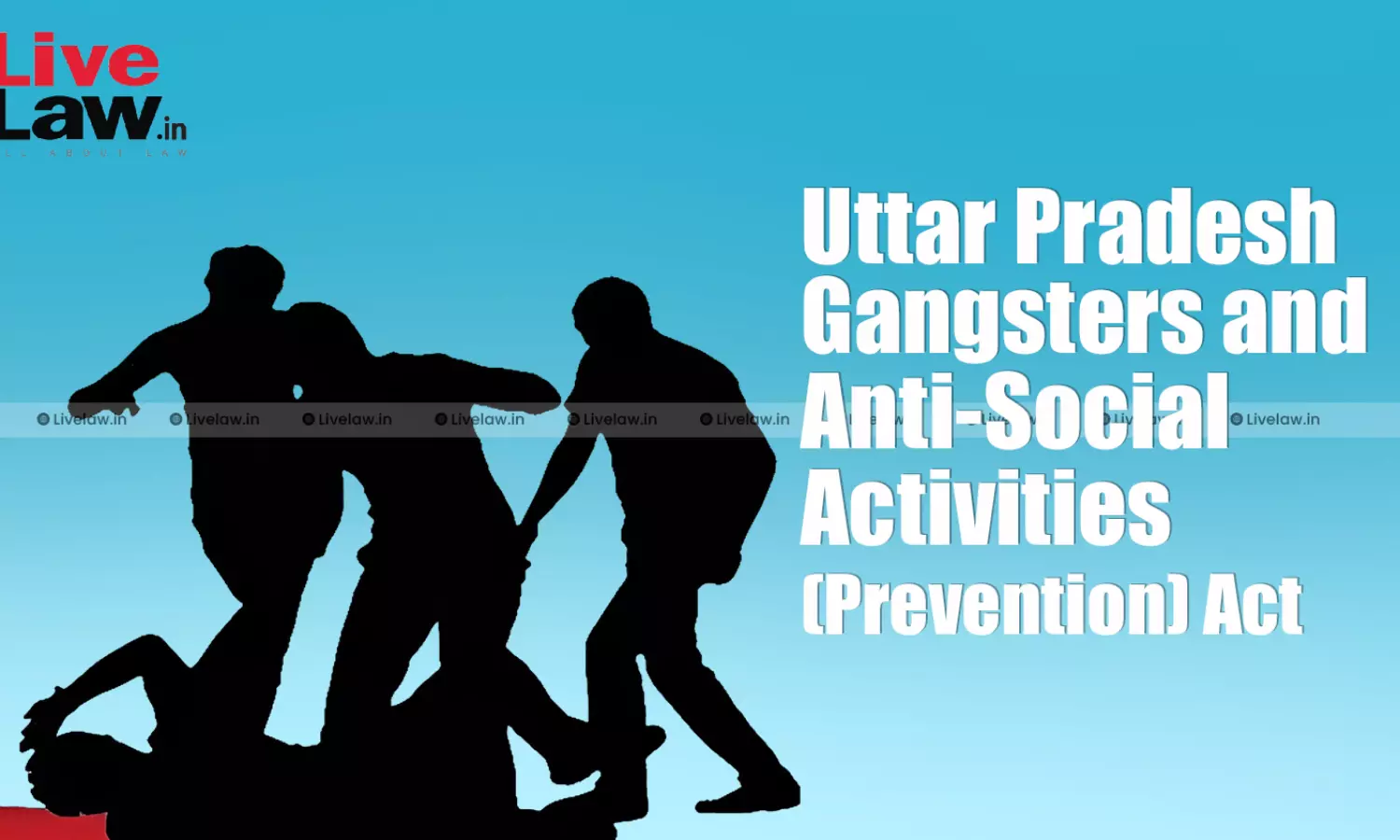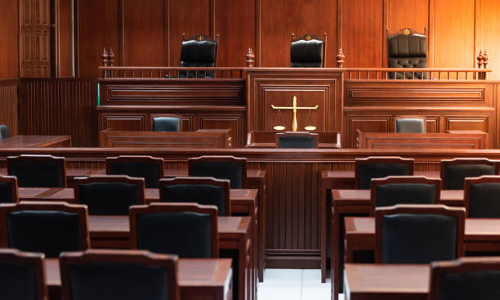
Recently in June 2023, Mukhtar Ansari, Ex-UP MLA, was awarded a life sentence in the 32-year-old Awadesh Narain murder case. A fine of Rs. 1 lakh has also been imposed upon him. The MP/MLA court in Varanasi announced the quantum of punishment. Last year, a special MP/MLA Court of Ghazipur convicted him under The Uttar Pradesh Gangsters and Anti-Social Activities (Prevention)...
Recently in June 2023, Mukhtar Ansari, Ex-UP MLA, was awarded a life sentence in the 32-year-old Awadesh Narain murder case. A fine of Rs. 1 lakh has also been imposed upon him. The MP/MLA court in Varanasi announced the quantum of punishment. Last year, a special MP/MLA Court of Ghazipur convicted him under The Uttar Pradesh Gangsters and Anti-Social Activities (Prevention) Act, 1986, sentencing him to 10 years imprisonment and a fine of Rupees 5 Lakh.
What is The Uttar Pradesh Gangsters and Anti-Social Activities (Prevention) Act?
The Uttar Pradesh Gangsters and Anti-Social Activities (Prevention) Act was introduced by Chief Minister Vir Bahadur Singh in 1986. The 24-Section long Act came into force on 15 January 1986 and aims at curbing the danger of organized crimes and anti-social activities in the State of Uttar Pradesh. The Act was enacted to maintain public order, ensure people's safety, and take stringent action against gangs, gangsters, and individuals involved in anti-social activities.
Since its inception in 1986 until March 2023, the UP-Gangster Act has registered 20,068 FIRs and around 64,039 individuals have been arrested, as documented by the UP police.
What is a gang, a gangster, and a public servant as defined under the Act?
Section 2(b) defines a "gang" as a group of people who indulge in anti-social activities, acting either individually or collectively, with the object of disturbing public order or gaining any undue advantage by using violence, threat, intimidation, or coercion. The provision lists several offenses which count as anti-social activities. These include crimes punishable under Chapter XVI, Chapter XVII, or Chapter XXII of the Indian Penal Code, offenses punishable under the Unlawful Activities (Prevention) Act, 1966, kidnapping, abduction, human trafficking, illegal transportation and smuggling of cattle, extortion, cheating, creating terror or panic in public and inciting others to resort to violence to disturb communal harmony.
Section 2(c) defines a "gangster" as a member, leader, or organizer of a gang, which includes any person who assists in the anti-social activities of a gang.
The term "public servant" is defined under section 2(d) of the Act. The term under this Act carries the same meaning as defined in Section 21 of the Indian Penal Code or any other law for the time being in force. It includes any person who lawfully assists the police or other State authorities in the investigation by giving information or evidence relating to such offense or offender.
Legislative Intent Behind the Act
"Legislation begins where evil begins", and so the UP-Gangster Act was made in the year 1986 with the intent to book 2500 well-known Gangster of the State and to put them behind bars to control the anti-social activities and organized crime around the State, including extortion, contract killing, land grabbing and illicit drug trade, etc.
Gangsterism and antisocial behavior were on the rise in the State, endangering the lives and property of the public. It was decided that existing regulations were insufficient to deal with this new threat. It was thought necessary to develop special arrangements for the prevention of, and for dealing with, gangsters and anti-social activities in the State to break the gangs by punishing the gangsters and putting an end to their nefarious objectives.
In addition to combating organized crime, the legislative intent behind the UP-Gangster Act also encompasses the goal of improving the efficiency and effectiveness of the criminal justice system. The act aims to streamline investigation procedures, expedite trials, and ensure the swift delivery of justice to victims of gangster-related crimes.
Aims and Objectives of the Act
The primary objective of the act is to prevent organized crimes and gangster activities within the State of Uttar Pradesh. It aims to dismantle criminal networks and prevent the growth of illicit activities. The Act empowers law enforcement agencies and State authorities to take necessary measures against gangsters to ensure the safety and security of the citizens. It provides provisions for the identification, tracking, and preventive detention of repeated offenders. By detaining repeat offenders, it seeks to prevent recidivism.
The act contains provisions that allow for the confiscation and forfeiture of any property obtained illegally or as a result of criminal activity under Section 14. The provision intends to target the financial gains of the gangsters, weaken their operations and deter others from engaging in similar anti-social activities. Under Section 5, the Act also provides to constitute Special Courts for the speedy trial of offenses under this Act to guarantee swift justice to the victims. The act aims at fostering a safe and peaceful environment in Uttar Pradesh.
Elements of the Act
Here are some elements that are to be considered when determining whether an individual should be booked under UP Gangster Act:
1. Involvement in Organised Criminal Activities: The accused may be involved in organized criminal activities, including offenses such as extortion, contract killings, drug trafficking, human trafficking, arms smuggling, or other serious criminal acts conducted as part of a criminal gang or organization.
2. Establishing a Pattern of Criminal Behaviour: There is often a requirement to establish a pattern of criminal behavior or a history of involvement in organized crime activities over a while. This helps differentiate between occasional criminal conduct and being an active member of a criminal gang.
3. Control or Influence over a Criminal Gang: The accused may have some level of control, authority, or influence over a criminal gang or organization. This could involve being a leader, organizer, coordinator, or key participant in the gang's activities.
4. Instilling Fear in the Public: The accused may be required to have a reputation or history of instilling fear in the public, either through their actions or through the activities of the criminal gang they are associated with. This fear factor distinguishes gangsters from individual criminals.
5. Collaboration or Membership in a Criminal Gang: The accused must be associated or connected with a recognized criminal gang or organization engaged in organized criminal activities. This association may be established through evidence of collaboration, membership, participation in gang activities, or adherence to the gang's structure and code of conduct.
6. Commission of Serious Criminal Offences: The accused may need to be involved in or associated with the commission of serious criminal offenses as part of the criminal gang's activities. These offenses typically involve significant harm or pose a threat to public safety.
Safeguards and Due Process
Even though the provisions of the Act are the safeguard measures to prevent gangsterism, the real meat and substance of the Act lie in the 67 rules of the recently notified Uttar Pradesh Gangster and Anti-Social Activities (Prevention) Rules 2021.
To initiate proceedings under the Act of 1986, the concerned in charge or the inspector of the police station needs to prepare a gang-chart. The gang-chart should include all the criminal activities of the gang in question. After receiving a clear recommendation from the additional superintendent of police, the gang-chart should be presented to the district head of the police. The gang-chart is subsequently anticipated to be approved by the commissioner of police or the district magistrate after establishing that sufficient grounds exist to take action.
Gang-chart is made based on "base cases," which are further defined under the rules. According to the rules, "base cases" refer to cases based on which a gang-chart has been made to take action against the gang in line with the 1986 Act. The rules state that the base case investigation must be completed before the gang-chart can be approved. Consequently, the Allahabad High Court declared that no one can be subjected to the Gangster Act without first filing a charge sheet in the base case. The certified copy of the charge sheet and recovery memo should also be attached to the gang-chart.
The 2021 rules also state that the direct participation or the presence of the accused at the scene of the incident is not mandatory. It further provides for the formation of three-tier committees at the State, divisional, and district levels for the regular monitoring and evaluation of the proceedings under the law.
Notable Judgements
(i) Single Crime Enough to Invoke Gangster Act
Hon'ble Supreme Court, in Shraddha Gupta v. State of Uttar Pradesh, 2022 SCC OnLine SC 514 was confronted if a person could get punished under the Gangsters Act of 1986 even when only a single FIR or charge sheet was lodged against them for any of the anti-social actions listed in section 2(b) of the act. The conclusion of the Hon'ble Court was that,
"Even a single crime committed by a 'Gang' is sufficient to implant Gangsters Act on such members of the 'Gang.' The definition clause does not engulf plurality of offense before the Gangsters Act is invoked".
(ii) Disturbance of Public Order Not Essential for Gang Classification
In Vinod Bihari Lal vs. State of UP, 2023 SCC Online All 143, Hon’ble Apex Court held that persons can be qualified as a gang within the meaning of section2(b) of the Gangster Act, 1986, even if there is no disturbance of public order by a group of persons.
"So far as the disturbance of public order is concerned, as already noticed hereinabove, a group of persons can have two alternate objects to qualify as a gang under Section 2(b) of the Act of 1986: They may have for their object the disturbance of public order or the gaining any undue temporal, pecuniary, material or another advantage for a member of the group or any other person. All that is necessary is that to attain either of the two objects, the group of persons, acting singly or in unison, should indulge in one of the enumerated anti-social activities envisaged under various clauses of sub-Section (b) of Section 2 of the Act of 1986."
(iii) Overt Act Not Essential for Booking under Gangster Act
The contention before the Allahabad High Court in Ashok Kumar Dixitvs. State of U.P.: AIR 1987 Allahabad 235 was whether a person can be booked under the UP-Gangster Act, if it is not proved that he did any overt act in furtherance to the crime? It was held that,
"For booking a person under the provisions of the Act the authorities have to be prima facie satisfied that a person has acted. The authority has to be satisfied that there is a reasonable and proximate connection between the occurrence and the activity of the person sought to be apprehended and that such activities were to achieve undue temporal, physical, economic or other advantage. There need not be any overt or positive act of the person intended to be apprehended at the place. It is enough to prove active complicity which has a bearing on the crime."
(iv) Non-Necessity of FIR and Gang Chart for Prosecution Proceedings
To address the issue of a dangerous gangster evading prosecution due to fear and lack of evidence, the Allahabad High Court in Irfan & Anr. Vs. State ofUP ruled that,
“Under the definition of gang, there is no compulsion of first information report of the incident of anti-social activity in the past, nor is there compulsion of any kind of gang table. No rules have yet been made under this Act. It is only to be determined on the basis of facts whether the action is subject to the definition or not. If clauses (xi) and (xxv) of section 2(b) are carefully examined, it would also cover those incidents where due to fear no one is able to file first information report against the offender. Therefore, it would not be wrong to hold the view that in certain circumstances, even if no crime was registered in the past, prosecution proceedings can be initiated under the Gangster Act.”
Criticisms and Controversies Surrounding the Act
The Uttar Pradesh Gangster Act, aimed at combating organized crime, has been subject to criticisms and controversies like other legislations.
(i) Abuse of Power
In December 2022, a petition was filed in the Supreme Court of India, challenging the constitutional validity of the Act. The petition alleged that the "act gives arbitrary powers to police/executive to invoke Gangsters Act against any person on their satisfaction without any reasonable classification."
It also challenged Section14 of the Act, which states that if the district magistrate is satisfied that a gangster has acquired a property by committing any offense under the Act, he may order the attachment of such property.
Additionally, it referred to Rule 57 of the 2021 Rules, which states that the trial under the Gangsters Act will take precedence over the base case trials under any other Act. This means that even if a person is declared not guilty in the main case, Gangsters Act proceedings may still be pending against him.
(ii) Guidelines not being followed
The Allahabad High Court has noted on several occasions that the guidelines provided in the Act are often misused. A bench of Justice Dinesh Singh of the Allahabad High Court in 2020 noted that "provisions of the Gangsters Act are being misused thoroughly in the State of U.P by the police."
Justice Singh was looking at the request for bail made by one Kapil Raidas, who had been charged under Section 2/3 of the Gangsters Act. The money seized on Raidas, according to the police, was the result of three alleged thefts. They also found some cigarette packets and Rs 6,600 on him. The claims made by the investigating officer did not sit well with the Court. In pursuance of this, UP Police notified the Court in January 2021 that new rules had been issued by the police on December 9, 2020, aimed at preventing the abuse of the legal provisions. The directions called for a committee headed by the district magistrate to review all cases filed under the Act every three months.
Laws concerning organized crime in other Indian states
In India, there is no specific national legislation to combat organized crime, offenders can be charged under the Immoral Traffic(Prevention) Act 1867, TheNational Security Act of 1980, ThePrevention of Illicit Traffic in Narcotic Drugs and Psychotropic Substances Actof 1988, and Section 120B of the Indian Penal Code (Criminal Conspiracy). To tackle organized crime, the majority of Indian states, including Maharashtra, Haryana, Gujarat, Andhra Pradesh, Karnataka, and Telangana, have adopted their own laws. The 7th Schedule of the Indian Constitution empowers state governments the authority to enact legislation that ensures an environment of tranquillity and security.
· The Maharashtra Control of Organized Crime Act, 1999
MCOCA is a legislation in the state of Maharashtra adopted in 1999, to combat the criminal networks that operate within. This law incorporates provisions that serve as deterrents, such as the power to intercept wire, electronic, or oral communications in order to prevent the committing of an offense and arrest offenders who have already committed one. The act provides stringent punishments which includes life imprisonment and death penalty, for those convicted of organized crimes. According to this Act, the police officer's confession may be used as evidence, and special courts hear the cases. In 2002, the Union Ministry of Home Affairs mandated that this Act be applied in Delhi, the National Capital Territory.
· The Karnataka Control of Organised Crime Act, 2000
The Maharashtra Control of Organized Crime Act, 1999 served as a model for the KarnatakaControl of Organized Crime Act, 2000, which was created to combat the rise in illegal activity in the state. Following the 2009 Amendment, terrorist activities are also included in the ambit of organized crimes. The penalty specified by this Act is similar to that specified in the MCOCA,1999. Additionally, this Act provides regulations for the creation of special courts and telephone interception. The Gauri Lankesh murder case in 2017 saw the implementation of the Act as a result of which 17 people were taken into custody.
Several other states like Telangana(Telangana Control of Organized Crime Act, 2001), Haryana(Haryana Control of Organized Crime Act, 2019), AndhraPradesh (Andhra Pradesh Control of Organized Crime Act 2001), Gujarat(Gujarat Control of Organised Crime Act,2003), have passed the similar legislatures to fight organized crimes in their states.
The Uttar Pradesh Gangsters and Anti-Social Activities (Prevention) Act, enacted in 1986, is a powerful tool in curbing organized crime and anti-social activities in the State of Uttar Pradesh. Its legislative intent was to tackle the growing menace of gangsterism and ensure public safety and order. Over the years, the act has resulted in numerous arrests and FIRs, showcasing its effectiveness in combating criminal networks.
The act defines a gang as a group of individuals involved in anti-social activities to disturb public order or gain undue advantage through violence or coercion. It also identifies gangsters as members, leaders, or organizers of such gangs. The act aims to dismantle criminal networks by targeting repeat offenders, confiscating their illegally obtained assets, and providing for the speedy trial of offenses.
While the act serves important objectives, criticisms, and controversies have surrounded its implementation. Concerns have been raised regarding potential abuse of power by the police and executive and the prioritization of Gangsters Act proceedings over base case trials. The misuse of the act and non-adherence to guidelines is often noted on several occasions.
Efforts have been made to address these issues, such as introducing new rules in 2021 to prevent abuse of the act's provisions. These rules include the establishment of committees for regular monitoring and evaluation of proceedings. However, continued vigilance and adherence to the guidelines must ensure the act is used judiciously and effectively.
In conclusion, the Uttar Pradesh Gangsters and Anti-Social Activities (Prevention) Act, 1986, plays a crucial role in maintaining public order, curbing organized crime, and ensuring the safety and security of citizens in Uttar Pradesh. While improvements are needed to address criticisms and controversies, the act, when implemented correctly, is essential in combating gangsterism and promoting a safe and peaceful environment in the State.
Views are personal.




